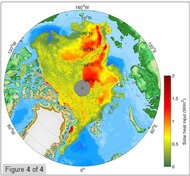Light absorption speeds melting of Arctic sea ice
(The New York Times) – The record-setting disappearance of Arctic sea ice this fall was an indication to many climate scientists and ice experts that the pace of climate change was outstripping predictions. Now a new study published this week in the journal Geophysical Research Letters provides a look at a dynamic that may further accelerate the process: the rate at which the ocean underneath the ice absorbs sunlight. The bottom line of the study, which was done by four scientists, three at the Alfred Wegener Institute for Polar and Marine Research in Bremerhaven, Germany, and one from the department of aerospace engineering sciences at the University of Colorado, Boulder, is that the ocean under newly formed ice (“first-year ice” in the scientists’ terminology) absorbs 50 percent more solar energy than the ocean beneath older ice (“multiyear ice”). This means that the more the ice melts in late summer, the more first-year ice replaces multiyear ice, and the warmer the ocean beneath the ice becomes, accelerating the melting process. One sentence of the study says it all: “a continuation of the observed sea-ice changes will increase the amount of light penetrating into the Arctic Ocean, enhancing sea-ice melt and affecting sea-ice and upper-ocean ecosystems.” [more]
